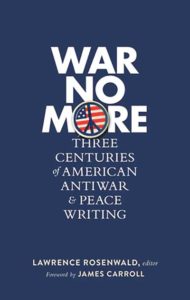War No More: Three Centuries of American Antiwar and Peace Writing
Reviewed by J.E. McNeil
June 1, 2017
 Edited by Lawrence Rosenwald. The Library of America, 2016. 850 pages. $40/hardcover; $17.99/eBook.
Edited by Lawrence Rosenwald. The Library of America, 2016. 850 pages. $40/hardcover; $17.99/eBook.
Buy from QuakerBooks
This is an ambitious book, and it looks it. Elegantly bound, complete with a satin ribbon bookmark attached, War No More intends to be a reference as well as a guide through the more than three centuries of Europeans in America—and before—starting with the pre-colonial preface of the Constitution of the Iroquois Confederacy. This book is an anthology and more.
What War No More is and is not is best understood when compared with Staughton Lynd and Alice Lynd’s Nonviolence in America published in 1995, if for no other reason than it is an anthology for much of the same time period. Rosenwald, in fact, often refers to the Lynd book in his introductions, and there are 13 identical essays included, as well as different essays from many of the same writers. The Lynds have two of Martin Luther King Jr.’s speeches, for example, and Rosenwald only one, but, in my opinion, the one outweighs the two by far. Rosenwald provides historical context for King’s “Beyond Vietnam” speech at Riverside Church in New York City about one year before his assassination—a critical moment in his career and life. Personally I have difficulty quoting this speech because every word is so important, and it still brings tears to my eyes to read it.
Looking at these two books helps clarify the difference between the nonviolent Civil Rights Movement and the peace movement. They often overlap, but are not the same. The Lynd book describes itself as a documentary history, using historical vignettes to frame the chosen essays. It is essentially political and is framed by the views of the Left. It skips the antiwar work done between World Wars I and II to make forays into workers’ rights and other social issues.
The Rosenwald book, on the other hand, makes clear connections between the antiwar movement in the United States that predated its founding and the peace movement today, carefully drawing lines from one author to another in often lengthy introductions, weaving with these essays a tapestry of a movement with a focus on peace and an understanding of justice.
Rosenwald has the advantage of 21 additional years to explore his themes using new voices such as Camilo Mejia, an Iraq War veteran and conscientious objector. Rosenwald includes some who did not stand conscientiously for peace as much as were “skeptical, sharp-eyed journalists.” In some of these later essays, while no position is taken on war, “war’s horrors are so unsparingly depicted that they seem to become exhibits in a case against war itself.”
It also contains a great deal of poetry and music and not just sentimental verses. It includes Mark Twain’s satirical take on the “Battle Hymn of the Republic (Brought Down to Date)” from the Spanish–American War period, which, with his “The War Prayer,” is familiar to many in the peace movement, though he could not get them published in his lifetime. Twain wrote “he expected as much, because ‘[n]one but the dead are permitted to tell the truth.’” You can also find one of my favorite Vietnam era songs from Country Joe and the Fish: “I-Feel-Like-I’m-Fixin’-To-Die Rag.”
To me, the most interesting entry was the “Book of Alma” from the Book of Mormon. The story is about a country under attack in which the king tells his army to “go into battle without weapons, refrain from self-defense, and [they] are slaughtered.” Their enemies “are so moved by the example of their opponents’ nonresistance that they are converted by it.” Who’d have thought? Not even the World War II Mormon conscientious objector I met many years ago (one of only ten) told me or his draft board that story in support of his status.
Rosenwald expertly chose and framed his choices for the reader to finish the anthology with a better understanding of what makes the peace movement unique among progressive movements. More than an anthology, this book resonates with songs and words over the years that will leave many asking, as Country Joe and the Fish did, “What are we fighting for?”



Comments on Friendsjournal.org may be used in the Forum of the print magazine and may be edited for length and clarity.